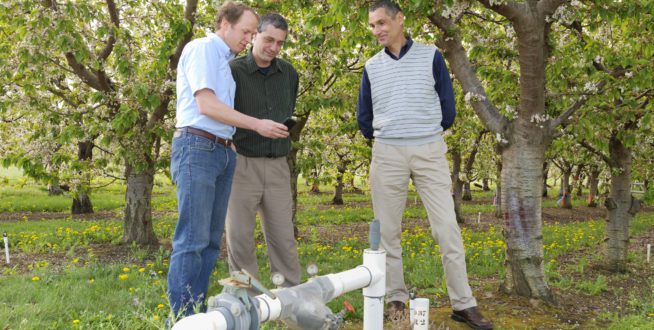

Jun 19, 2019Modern irrigation tools move closer to automation
Growers still bear responsibility for irrigating specialty crops, but technology offers a few helping hands for the task.
Sensors detect moisture in the air or soil. Weather networks record historical temperatures. And free-to-download phone apps calculate evapotranspiration, allowing growers to decide how much water the crops need.
R. Troy Peters, a professor and Extension irrigation engineer at Washington State University’s Irrigated Agriculture Research and Extension Center, helped develop Irrigation Scheduler Mobile, an app that’s been available to Washington growers for years and that now works with weather networks in about a dozen states in the West, from California to Arizona, Colorado and the Dakotas. The app helps growers plan out and organize their irrigation.
Growers input data about their own land and crops that allows the app to calculate evapotranspiration, which is the amount of water that’s evaporated or been used by the plant and needs to be replaced. The calculation depends on weather data as well as coefficients set by the program. The grower-inputted data is private but is held on computer servers owned by the agricultural weather services. For large agricultural providers, the data can be accessed by several people with different devices.


Those calculations get complicated pretty quickly, Peters said. For instance, with apples, the crop coefficients depend on the cultivar, the density it’s planted at and even the trellis system. The app will load some default or baseline values based on what the grower inputs, but the grower may tweak those coefficients later on. Growers at educational sessions often approach him for help to fine-tune their individual settings.
Depending on the grower’s unique farm, “the model could be off, and if it is off, how would they tweak it? That is a steep learning curve,” Peters said.
Another common issue is the growers have to accurately record the water they apply. Peters said this is not an issue for big operations as much as it is with part-time farmers with day jobs in the city.
And, in most cases, growers still have to carry out the irrigation plans. Complete irrigation automation can be a big gamble.
“Doing it wrong? There’s a lot of liability associated with that,” Peters said. “Buying a center pivot for potatoes is pretty expensive.”
He didn’t rule out, though, that it’s possible.
“The future, I think, is going to be toward automation,” he said. Safeguards would have to be built in.
Some companies are pushing toward that future.
Onset data loggers, once used mostly for agricultural and environmental research, are now being marketed directly to Northeastern growers. Onset recently announced a partnership that would allow growers using its HOBO-brand weather stations to plug into disease- and pest-forecasting from the Network for Environment and Weather Applications (NEWA), a 24-state weather network. A single soil moisture sensor costs $250; a simple frost alarm or soil moisture system is about $1,500 and a NEWA-compatible weather station with a “full complement” of sensors can total $2,500.


Paul Gannett, Onset’s outdoor product marketer, said cranberry growers in Cape Cod, Massachusetts, have been using NEWA and private weather stations to stay in front of possible freezes. The growers are concerned with frost conditions both early in the season where the plants are starting to bud out, and in the fall when the fruit is waiting for the harvest.
“They need to turn on their irrigation systems as frost mitigation,” he said. “They don’t wait for it to get to 32 degrees.”
Cranberry growers can set up a system of wireless sensors that measure temperatures at different points around the bog, Gannett said. They set a “critical threshold” in the software and are alerted by text, email and landline phone if that threshold is crossed.
Onset’s system can even pull the trigger on the anti-frost measures, including irrigation. Growers can remotely override that when they receive a notification, and most double-check their irrigation systems anyway.
“It turns them on, sends them a notification and then because it’s so critical, a lot of them will go out and check if their systems are on,” Gannett said. Another option is to have water pressure sensors put into their irrigation systems, to remotely verify the irrigation has been turned on.
Gannett said many growers still balk at wiring irrigation controls into computerized networks of sensors.
“They want the information to make the decisions, but a lot of them want to make that decision themselves,” he said. “At least if it turns on the system automatically, they want to be able to have the ability to override that. … They definitely want to feel like they’re in control.”
– Stephen Kloosterman, associate editor
Above, Irrigation Scheduler developer R. Troy Peters, left, talks with AgWeather Net Director Gerrit Googenboom and AgWeatherNet Web Developer Sean Hill. Photo: Washington State University














